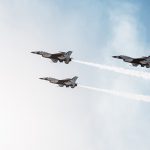The Soviet Union’s Tupolev Tu-4 strategic bomber, which entered service in 1949, represented one of the most glaring episodes of intellectual property theft in aviation history.
Although the Cold War did not officially begin until after the Second World War concluded, the fact of the matter is that the United States and Soviet Union had been vicious enemies long before that conflict began. That reality was defined by the opposition that Washington had to the Marxist-Leninists who assumed power in the middle of the First World War—with the United States even deploying troops to northern Russia to help the pro-tsarist forces in the Russian Civil War. Within its own borders, the US government went on an anti-communist spree in the form of the “Palmer Raids” during the late 1910s and early 1920s.
Even as the Second World War began, the Americans were understandably suspicious of the Soviets. Remember, initially in the war, Moscow was in an alliance with Hitler’s Germany. The two nations conquered Poland together, for instance.
Once Adolf Hitler turned on the Soviets, Joseph Stalin, the leader of the USSR, needed to find new allies. Six months later, when the United States entered the war after the Japanese attack on Pearl Harbor, he found the Americans. But the alliance was always one of convenience only. The old rivalries and doubts persisted. Indeed, from the Soviet side, the relationship was far more parasitic than it has commonly been remembered.
The Soviet Union Stole Aircraft Designs from the Americans
One concrete example of the parasitic relationship that Stalin had with the Americans was in the way that the Soviets exploited their alliance with the United States to engage in wanton industrial theft. It is well-known today that the Soviet Union had thoroughly penetrated the American nuclear weapons program, with spies like Klaus Fuchs passing on information to Moscow—leading the Soviets to conduct their first successful nuclear test in 1949, only four years after the Americans.
But the Soviets stole many other technologies, too. For instance, the Soviet Union’s Tupolev Tu-4 strategic bomber, which entered service in 1949, represented one of the most glaring episodes of intellectual property theft in aviation history. The Soviet plane was a carbon copy of the American Boeing B-29 Superfortress. The plane was meant to close the gap with the Americans in terms of the USSR’s strategic bombing capabilities during the early Cold War.
The B-29 was a technological marvel of its time. Introduced during the Second World War, the bird had a pressurized cabin, advanced fire-control systems, and long-range capabilities. The B-29 played a decisive role in the Pacific Theater of WWII, most notably in firebombing Japanese cities and dropping the atomic bombs on Hiroshima and Nagasaki. The Soviets lacked long-range bombing capacity of the kind that the Americans possessed with their iconic B-29.
Four battle-damaged B-29s made emergency landings in Soviet territory in 1944 after bombing missions against Japanese targets in Manchuria. Under international agreements, the crews were interned—as the Soviet Union was not then at war with Japan, returning the pilots to American territory would have been viewed by Tokyo as an act of aggression—but the aircraft themselves were retained by the Soviets, who saw them as a potential blueprint for their own bomber program.
Stalin ordered the legendary Tupolev Design Bureau, led by iconoclastic designer Andrei Tupolev, to reverse-engineer the B-29 and produce a Soviet variant of the plane. The B-29 was copied down to its tiniest details.
A monumental undertaking, the development of the Tu-4 by Tupolev Design Bureau replicating the B-29s posed significant challenges to the Soviet engineers. Its airframe was constructed with lightweight aluminum alloys that required precision manufacturing techniques unfamiliar to the Soviets at the time. The Wright R-3350 radial engines, known for their power as well as their reliability issues, had no direct Soviet equivalent.
Soviet engineers further struggled in replicating the B-29s advanced systems. The American bird had remote-controlled gun turrets, a Norden bombsight, and pressurized crew compartments. Under intense pressure to meet Stalin’s deadlines, the Soviet engineers faced the additional hurdle of converting American measurements (in inches) to the metric system, though they often retained imperial units to ensure fidelity to the original design.
Thousands of Soviet engineers were mobilized by Tupolev Design Bureau, along with technicians and workers from across multiple other design bureaus and factories. The Shvestov Ash-73 radial engine, a derivative of an earlier Soviet design, was modified to approximate the R-3350’s performance, delivering 2,400-horsepower per engine.
Soviet analogues were developed for the B-29s electronics—though some of the Tu-4’s systems, such as its fire-control computers, were less advanced than their US counterparts. The Tu-4’s defensive armament mirrored the B-29’s ten, .50-caliber machine guns, but later models replaced these with 23mm cannons for improved firepower.
Remarkably, the Soviets even replicated minor details of the B-29, from the shape of the wing rivets to the color of the cockpit paint.
The History of the Tu-4 Bomber
The first Tu-4 flew on May 19, 1947, just two years after the project in the USSR began, a testament to the scale and intensity of the effort. Around 850 units were built between 1947 and 1952. The Tu-4 had a maximum range of 5,400 miles and a payload capacity of up to 20,000 pounds. These birds could carry conventional or nuclear bombs, including early Soviet atomic weapons. Its performance was nearly identical to the B-29’s, with a top speed of 357 miles per hour, and a service ceiling of 36,000 feet.
When the USSR introduced the Tu-4, it immediately shifted the geopolitical dynamic in the budding Cold War. That, paired with the Soviet Union’s development of the atomic bomb in 1949, fundamentally altered the trajectory of world affairs. The US was forced to bolster its air defenses and accelerate the development of interceptors, such as the jet-powered F-86 Sabre.
Today, few Tu-4s survive, with examples preserved in museums in Russia, standing as relics of a time when espionage and engineering were as critical to warfare as the bombs that these planes were designed to drop on their enemies.
But the notion of intellectual property theft is far more widespread today. In the current period, it is the People’s Republic of China that routinely engages in wanton espionage against the Americans—and with far more productive results for Beijing than the Tu-4 was for Moscow.
About the Author: Brandon J. Weichert
Brandon J. Weichert, a Senior National Security Editor at The National Interest as well as a contributor at Popular Mechanics, who consults regularly with various government institutions and private organizations on geopolitical issues. Weichert’s writings have appeared in multiple publications, including the Washington Times, National Review, The American Spectator, MSN, the Asia Times, and countless others. His books include Winning Space: How America Remains a Superpower, Biohacked: China’s Race to Control Life, and The Shadow War: Iran’s Quest for Supremacy. His newest book, A Disaster of Our Own Making: How the West Lost Ukraine is available for purchase wherever books are sold. He can be followed via Twitter @WeTheBrandon.
Image: Shutterstock / fifg.


















